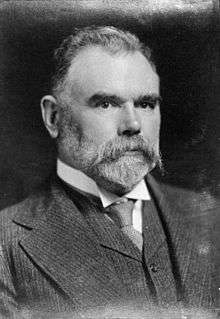Thomas Mackenzie
Sir Thomas Mackenzie GCMG (10 March 1853 – 14 February 1930) was a Scottish-born New Zealand politician and explorer who briefly served as the 18th Prime Minister of New Zealand in 1912, and later served as New Zealand High Commissioner in London.
Sir Thomas Mackenzie | |
|---|---|
 | |
| 18th Prime Minister of New Zealand | |
| In office 28 March 1912 – 10 July 1912 | |
| Monarch | George V |
| Governor | John Dickson-Poynder |
| Preceded by | Joseph Ward |
| Succeeded by | William Massey |
| Constituency | Egmont |
| Personal details | |
| Born | 10 March 1853 Edinburgh, Scotland |
| Died | 14 February 1930 (aged 76) Dunedin, New Zealand |
| Resting place | Dunedin Northern Cemetery |
| Political party | Liberal |
| Spouse(s) | Ida Henrietta Nantes
( m. 1884; died 1926) |
| Children | 7, including Clutha |
Early years
Mackenzie was born in Edinburgh. His family emigrated to New Zealand in 1858 when he was four and Mackenzie was educated at Green Island School and at the Stone School, both in Dunedin. He tried his hand at surveying, farming and commerce.[1]
Member of Parliament
| New Zealand Parliament | ||||
| Years | Term | Electorate | Party | |
| 1887–1890 | 10th | Clutha | Independent | |
| 1890–1893 | 11th | Clutha | Liberal | |
| 1893–1896 | 12th | Clutha | Liberal | |
| 1900–1902 | 14th | Waihemo | Liberal | |
| 1902–1905 | 15th | Waikouaiti | Liberal | |
| 1905–1908 | 16th | Waikouaiti | Liberal | |
| 1908–1911 | 17th | Taieri | Liberal | |
| 1911–1912 | 18th | Egmont | Liberal | |
Mackenzie was elected to the New Zealand Parliament for Clutha in 1887. He resigned in 1896 to assess the British markets for New Zealand products and remained in his native land for three years. On his return to New Zealand he was elected to Parliament successively for Waihemo 1900–1902, Waikouaiti 1902–1908, Taieri 1908–1911 and Egmont (in the North Island) 1911–1912, never losing an election.
Mackenzie was also a notable explorer. He was a member of expeditions to the Tautuku Forest (1883), the wild country between Milford Sound and Lake Te Anau (1888; discovered the Sutherland Falls), and the Matterhorn Mountains (1888; discovered a pass between Lake Manapouri and Hall Arm). He was the first person to try to map an overland route to Dusky Sound (1894–1896). He crossed the land between Lake Te Anau and Lake Wakatipu in 1907.
Minister and Prime Minister
In January 1909 he was appointed Minister of Industries and Commerce, Tourist and Health Resorts, Scenery Preservation and State Forestry Departments in the government of Sir Joseph Ward. In May he also became Minister of Agriculture with a seat in the Cabinet. He was then successively Minister of Customs, Minister of Education and Postmaster-General. In May 1912 he succeeded Ward as Prime Minister and also served as Minister of Lands.
Mackenzie's Ministry was criticised by both the opposition and Liberal dissidents. Liberal MP Roderick McKenzie stated that Mackenzie's ministers were political novices who had forsaken their liberal principles and John Millar should have been Ward's successor as Prime Minister.[2]
The Mackenzie government survived only until July 1912 when he lost a vote of no confidence and was appointed High Commissioner in London. He served in this role until 1920 and was New Zealand delegate at the peace conferences with Austria, Bulgaria and Turkey in 1919, a member of the Dardanelles Commission and the Imperial War Graves Commission (later the Commonwealth War Graves Conmmission). In March 1921 he was appointed member of the New Zealand Legislative Council for Otago.
Later years
He was appointed Knight Commander of the Order of St Michael and St George (KCMG) in the 1916 New Year Honours (1 January 1916)[3] and promoted to Knight Grand Cross (GCMG) in June 1920.[4]
His son Clutha Mackenzie who was blinded at Gallipoli was active in work for the blind.[1] In 1923 he supported Val Sanderson in establishing the Native Bird Protection Society (later the Royal Forest and Bird Protection Society of New Zealand) and was the society's first president.[5]
Mackenzie died in Dunedin in 1930 and was buried in the Dunedin Northern Cemetery.[6]
See also
Notes
- Brooking, Tom. "Mackenzie, Thomas Noble 1853–1930". Dictionary of New Zealand Biography. Ministry for Culture and Heritage. Retrieved 10 December 2011.
- Bassett 1982, p. 12-13.
- "No. 29423". The London Gazette (Supplement). 31 December 1915. p. 82.
- "No. 13609". The Edinburgh Gazette. 29 June 1920. p. 1523.
- Galbreath, Ross. "Ernest Valentine Sanderson". Dictionary of New Zealand Biography. Ministry for Culture and Heritage. Retrieved 27 September 2016.
- "Cemeteries search". Dunedin City Council. Retrieved 20 December 2014.
References
External links
| Wikimedia Commons has media related to Thomas Mackenzie. |
- Page on Thomas Mackenzie at New Zealand Prime Minister Website
- Biography in 1966 Encyclopaedia of New Zealand
- Dusky Track, New Zealand
| Government offices | ||
|---|---|---|
| Preceded by Joseph Ward |
Prime Minister of New Zealand 1912 |
Succeeded by William Massey |
| New Zealand Parliament | ||
| Preceded by James William Thomson |
Member of Parliament for Clutha 1887–1896 |
Succeeded by James William Thomson |
| Preceded by John McKenzie |
Member of Parliament for Waihemo 1900–1902 |
Constituency abolished |
| Preceded by Edmund Allen |
Member of Parliament for Waikouaiti 1902–1908 | |
| Preceded by Donald Reid |
Member of Parliament for Taieri 1908–1911 | |
| Preceded by Bradshaw Dive |
Member of Parliament for Egmont 1911–1912 |
Succeeded by Charles Wilkinson |
| Diplomatic posts | ||
| Preceded by William Hall-Jones |
High Commissioner of New Zealand to the United Kingdom 1912–1920 |
Succeeded by James Allen |